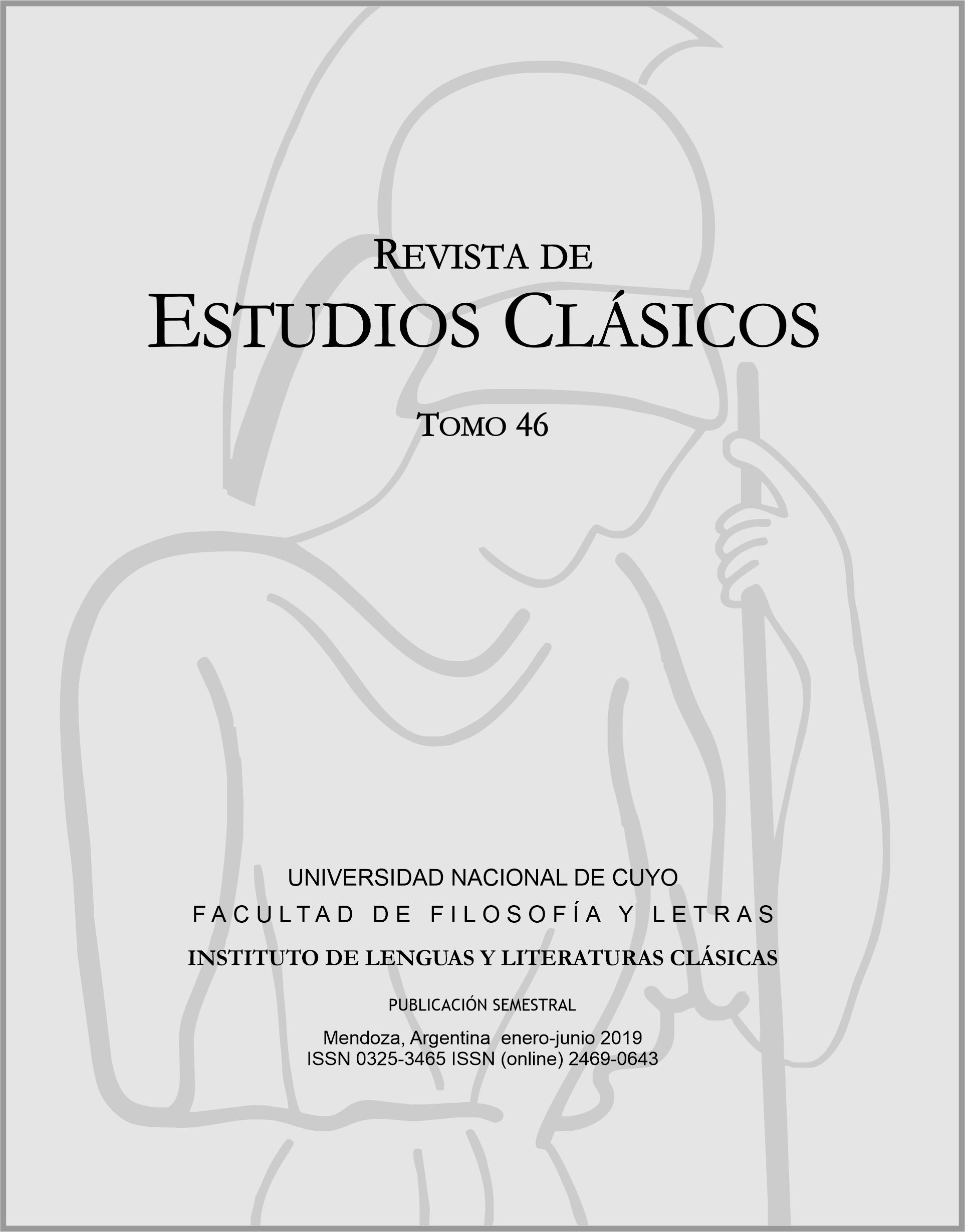ΠΟΛΥΣΙΝΗΣ ΚΥΩΝ: Electra, Coéforas y la construcción del estatus femenino en la Orestía
Keywords:
Aeschylus, Choephoroe, Oresteia, Electra, gender, female statusAbstract
Choephoroe’s Electra has not been thoroughly studied by scholars, who have been instead focused on comparing her to namesake heroines by Sophocles and Euripides in order to show the differences and similarities between them, and to determine whether her character is essential for the piece’s dramatic structure and can therefore be considered autonomous. This paper intends to answer why she is included in the trilogy. After tracing pre-Aeschylean sources and analyzing from a gender perspective the ambiguous traits defining her as a female subject, we will hypothesize that Electra’s presence cannot be explained by dramatic reasons but ideological and structural ones. Agamemnon’s daughter provides the spectator with a true role model "’one acceptable to the polis"’ which offsets the "anomalous" image of women in the trilogy and semantically anticipates Athena’s appearance in Eumenides.
References
Auer, J. (2006). The Aeschylean Electra. Greek, Roman and Byzantine Studies, 46, 249-273.
Rodríguez Adrados (ed.) (2010). Esquilo. Tragedias, IV. Coéforos, Euménides. Trad. y notas de E. Calderón Dorda. Madrid: CSIC.
Carson, A. (1990). Putting Her in Her Place: Women, Dirt, and Desire. En D. Halperin, J. Winkler, J. & F. Zeitlin. Before Sexuality: The Construction of Erotic Experience in the Ancient Greek World. Princeton: Princeton University Press, pp. 135-170.
Conacher, D. (1987). Aeschylus’ Oresteia. A Literary Commentary. Toronto: University of Toronto Press.
Crespo, M. I. (2016), Ἄνανδροι Ἀµαζόνες: conflicto trágico y subjetividad femenina en las Suplicantes de Esquilo". Incluido en el Dossier "Teatro, sociedad y política en la Atenas clásica", Saga, Revista de Letras, 5 (primer semestre), 22-69.
Crespo, M. I. (2012). Dýsplanos parthénos. La víctima femenina como híbrido monstruoso en el Prometeo Encadenado. En A. Atienza, A.; D. Battistón, D.; E. Buis, E.; M. I. Crespo et al. (eds.). Nostoi. Estudios a la memoria de Elena Huber. Buenos Aires: Eudeba, pp. 195-214.
Crespo, M. I. (2010). Sophè gyné. Mujer y saber, obediencia y libertad: la "desfeminización" de Casandra en el discurso dramático de Agamenón. [Versión corregida y aumentada en espera de nueva publicación de (1998). Sophè gyné: la ‘desfeminización’ de Casandra en el discurso dramático del Agamenón", Actas de las IX Jornadas de Estudios Clásicos, "Mito y religión en la cultura grecolatina" (25-27 de junio de 1997), UCA: Buenos Aires, pp. 89-96.]
Crespo, M. I. (2000). Ἀνδρόβουλος γυνή, δύσθεος γυνή: la construcción de Clitemnestra como heroína trágica en el discurso dramático de la Orestía. En Caballero de del Sastre, E.; Huber, E. et al. (eds.), El discurso femenino en la literatura grecolatina, Centro de Estudios Latinos – Facultad de Humanidades y Artes (Universidad Nacional de Rosario), Rosario: Homo Sapiens, pp. 67-108.
Crespo, M. I. (1999). Δόµων ἄγαλµα: la desubjetivación de la heroína trágica en el discurso dramático del Agamenón. Anales de Filología Clásica, XV, 94-106.
de Romilly, J. (1992), L´hesitation et le regret dans les tragedies antiques relatives a Electre. Bulletin de l’Association Guillaume Budé, 3, 237-248.
Diggle, J. (1970). A transposition in the Choephori. Classical Review, 20, 267-269.
Fitton-Brown, A. (1961). The Recognition Scene in Choephori. Revue des Études Grecques, 74, 363-370.
Foley, H. (2001). Female Acts in Greek Tragedy, Princeton & Oxford: Princeton University Press.
Garvie, A. (ed.) (1986). Aeschylus, Choephori. Oxford: Clarendon Press.
Goldhill, S. (1984). Definition, paradox, reversal: τοῦ πατρός in the Choephoroi. En Language, Sexuality, Narrative: the Oresteia. Cambridge: Cambridge University Press, pp. 99-207.
Hughes Fowler, B. (2007). The imagery of Choephoroe. En M. Lloyd, (ed.). Aeschylus. Oxford Readings in Classical Studies. Oxford: Oxford University Press, pp. 302-315.
Jebb, R. (ed.) (1924). Sophocles, Electra. Oxford: Oxford University Press.
Kakridis, J. (1949). Hectorea. En Homeric researches. Lund: C.W.K. Gleerup, pp. 43-64.
Mezzadri, B. (1997). Euripide à contre-pied (À propos des Choéphores, 205-211 et de l’Électre d’Euripide, 532-537). En A. Moreau, A. y P. Sauzeau, (eds.), Les Choéphores d’Eschyle, Montpellier: Université Paul Valéry, pp. 87-106.
Podlecki, A. (1981). Four Electras. Florilegium, 3, 21-46.
Podlecki, A. (1983). Aeschylus’ women. Helios, 10, 23-47.
Rabinowitz, N. (1981). From force to persuasion: Aeschylus' Oresteia as a cosmogonic myth. Ramus, 10, 159-191.
Roux, G. (1974). Commentaires à l’Orestie. Revue des Études Grecques, 87, 33-79.
Sommerstein, A. (1980). Notes on the Oresteia. Bulletin of the Institute of Classical Studies, 27, 63-75.
Sommerstein, A. (ed.) (2008). Aeschylus II, Oresteia: Agamemnon – Libation Bearers – Eumenides. Cambridge (Ma.)–London: Harvard University Press.
Tarkow, T. (1979). Electra´s Role in the Opening Scene of the Choephoroi. Eranos, 77, 11-21.
West, M. (ed.) (1990). Aeschyli Tragoediae cum incerti poetae Prometheo. Stutgardiae: in aedibus B.G. Teubneri.
Wiles, D. (1988), The Staging of the Recognition Scene in the Choephoroi. Classical Quarterly, 38, 82-85.
Zeitlin, F. (1984). The dinamics of misogyny: myth and mythmaking in the Oresteia. En J. Peradotto & J. Sullivan (eds), Women in the Ancient World. The Arethusa Papers. New York: State University of New York Press, pp. 159-191.
Downloads
How to Cite
Issue
Section
License
Aquellos autores/as que tengan publicaciones con esta revista, aceptan los términos siguientes:
- Los autores/as conservarán sus derechos de autor y garantizarán a la revista el derecho de primera publicación de su obra, el cuál estará simultáneamente sujeto a laLicencia Creative Commons Atribución-NoComercial-CompartirIgual 2.5 Argentina (CC BY-NC-SA 2.5 AR). (https://creativecommons.org/licenses/by-nc-sa/2.5/ar/)que permite a terceros compartir la obra siempre que se indique su autor y su primera publicación esta revista.
- Los autores/as podrán adoptar otros acuerdos de licencia no exclusiva de distribución de la versión de la obra publicada (p. ej.: depositarla en un archivo telemático institucional o publicarla en un volumen monográfico) siempre que se indique la publicación inicial en esta revista.
- Se permite y recomienda a los autores/as difundir su obra a través de Internet (p. ej.: en archivos telemáticos institucionales o en su página web) antes y durante el proceso de envío, lo cual puede producir intercambios interesantes y aumentar las citas de la obra publicada. (Véase El efecto del acceso abierto).












